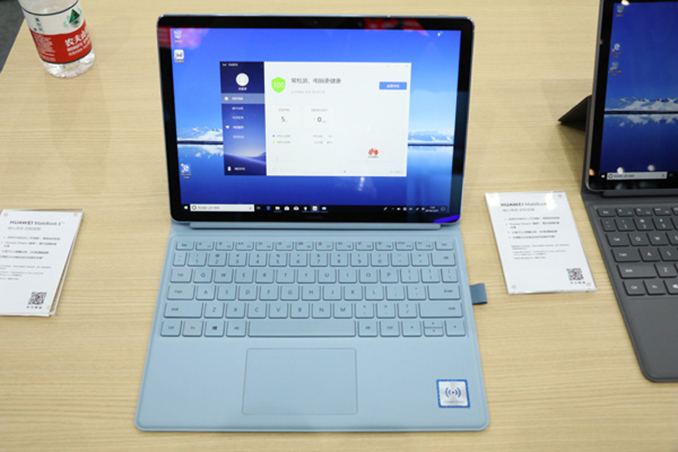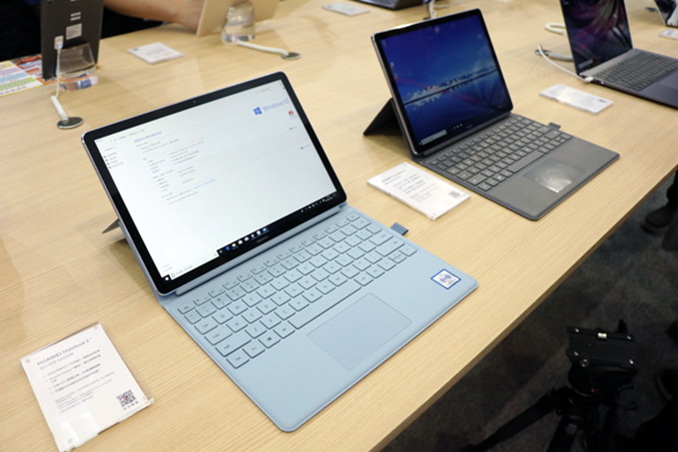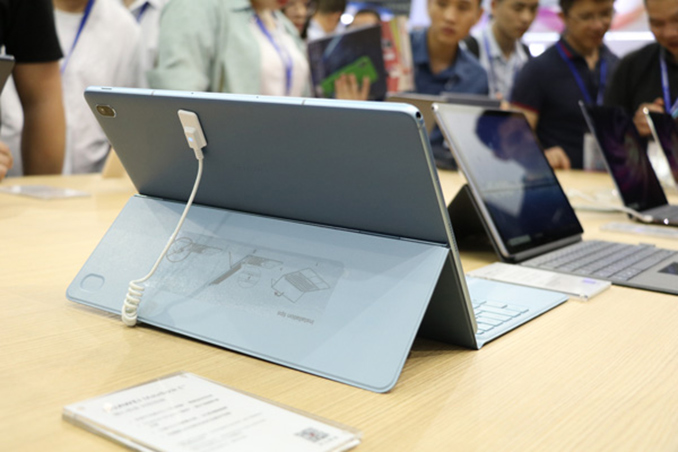Huawei Readies Windows 10 Laptop Based on Qualcomm Snapdragon 850
by Anton Shilov on April 11, 2019 4:00 PM EST- Posted in
- Laptops
- Qualcomm
- Huawei
- Notebooks
- 2-in-1
- Matebook E
- Snapdragon 850

Being a relatively new maker of laptops, Huawei is trying to address high-end and niche markets to gain share, avoid direct competition with numerous rivals at the same time, and preserve its profit margins. With numerous ultra-portable Intel Core-based notebooks in its arsenal, Huawei is working on a Windows 10 on Snapdragon 2-in-1 PC for those who want an always-connected machine.
The Huawei Matebook E 2019 is actually even more portable than the company’s existing offerings. The convertible 2-in-1 notebook comes equipped with a 12-inch display featuring a 2160×1440 resolution, 400 nits brightness, and a 3:2 aspect ratio. The chassis of the tablet (as well as its kickstand) is made of an unknown metal alloy and is 8.5 mm thick, which is a tad thicker when compared to other offerings in this segment. Meanwhile, the tablet itself weighs 690 grams without its keyboard cover and about a kilogram with it, bringing the weight of the whole system to the level comparable with ultra-light notebooks. Speaking of keyboard, it has a relatively large touchpad and an NFC chip to enable Huawei’s Share OneHop service, but no backlighting. Besides, it can hold Huawei’s M-Pen stylus.
The Matebook E is based on the Qualcomm Snapdragon 850 SoC (four Kryo 385 cores at 2.96 GHz, four Kryo 385 cores at 1.7 GHz, Adreno 630 GPU) which is accompanied by 4 or 8 GB of LPDDR4X memory as well as 128 or 256 GB of USF NAND flash storage (it is unclear whether it is expandable using a microSD card). Since we are dealing with a machine powered by a platform originally designed with mobility and connectivity in mind, the Matebook E supports everything you come to expect from an Always Connected PC (ACPC), including the X20 LTE modem (Cat 18, 5CA, 4x4 MIMO, up to 1.2 Gbps DL, up to 150 Mbps U, 802.11ac Wi-Fi, and Bluetooth 4.1. Interestingly, the Matebook E is outfitted with an eSIM, but also has a slot for a regular nano SIM card.
The tablet also has a USB Type-C connector, a fingerprint reader, two stereo speakers, and a 3.5-mm TRRS audio jack. Obviously for a 2-in-1 form-factor, the Matebook E feature the same set of sensors as regular tablets, including an accelerometer, a gyro, a light sensor, and so on. As for battery, it has a built-in 36.3 Wh battery that can last up to 20 hours.
When it comes to imaging, the 2-in-1 notebook has a 20 MP main cam with autofocus and a LED flash, as well as a 5 MP camera for selfies.
Huawei plans to launch its Matebook E 2-in-1 convertible in China already next month, but it is unclear when and if the company intends to release it on other markets as well.
| Specifications of Huawei's Windows on Arm 2-in-1 | ||
| Matebook E 2019 | ||
| Display | 12-inch, 2160×1440 216 PPI |
|
| CPU | Qualcomm Snapdragon 850 4 x Kryo 385 at 2.96 GHz 4 x Kryo 385 at 1.7 GHz |
|
| Graphics | Adreno 630 GB | |
| RAM | 4 or 8 GB LPDDR4X | |
| Storage | 128 or 256 GB UFS | |
| Wi-Fi | 802.11ac Wi-Fi | |
| Bluetooth | 4.1 | |
| WWAN | Qualcomm X20 Gigabit LTE Cat 18, 5CA, 4x4 MIMO, up to 1.2 Gbps DL, up to 150 Mbps UL |
|
| USB | 3.0 | 1 × Type-C |
| Cameras | Front | 5 MP |
| Rear | 20 MP | |
| Other I/O | Microphone, stereo speakers, audio jack, trackpad, etc. | |
| Battery | 36.3 Wh | |
| Battery Life | 20 hours | |
| Dimensions | Width | ? |
| Height | ? | |
| Thickness | 8.5 mm | |
| Weight | Tablet | 690 grams |
| Tablet+KB | ~1000 grams | |
| Price | ? | |
Why Snapdragon and not Kirin?
Ian: When we were at Mobile World Congress, I put it to HiSilicon if they were planning to build a chip for Windows based notebooks with the name Kirin. They said that they were not, for the simple reason that the market is not yet mature. They are more than happy to let other chip manufacturers build a market first, before they insert their own hardware, and would potentially join a mature market, but not at this time. Despite this, this new product shows that Huawei is willing to at least dip its toe into the water with the already verified solutions on the market, even if it isn't Huawei's own chips just yet.
Related Reading
- Samsung Unveils Galaxy Book2: 12-Inch, Snapdragon 850 with X20 LTE, 20 Hrs
- Lenovo Announces Yoga C630: The First Windows on Snapdragon 850
- Qualcomm Announces Snapdragon 850: A Second Generation For Windows
- Lenovo’s Miix 630 Snapdragon 835-Based 2-in-1 Now Available
- HP’s Snapdragon 835-Based Envy X2 2-in-1 Available for Pre-Order, Starts at $999
- Lenovo Unveils Miix 630 2-in-1: Windows 10 S, Snapdragon 835, Gigabit LTE, 20 Hrs
- ASUS Announces the NovaGo (TP370): A Snapdragon 835 based Windows 10 PC
Source: NotebookItalia.it (via Liliputing)













39 Comments
View All Comments
Diogene7 - Saturday, April 13, 2019 - link
@CalistaI agree with you : I would prefer a fanless (quiet) and much longer battery life computer, and if most of the time (95%+) I spent using my computer on a regular basis are with apps are optimized to run natively ARM processor, I am all in for an ARM based computer.
The operating system (Windows 10), the office suite Microsoft Office are already optimized to run natively on ARM processor.
I read somewhere that there is some work done to port internet browser Chrome and Firefox on ARM processor.
There is already a version of the videoplayer VLC optimized for ARM.
Until x86 apps are not too sluggish when using the emulation layer (= if performance is good enough), then I would happily consider buying a Windows on ARM (WoA) computer...
I am actually really looking forward to see tests and benchmark of Windows computer that have the processor Qualcomm Snapdragon 8cx : it looks promising, but it may still need 1 or 2 more years to mature a bit...
s.yu - Friday, April 12, 2019 - link
I haven't found any 850 powered device that doesn't have performance issues in fact, those were out last year, and now this...coschizza - Friday, April 12, 2019 - link
x64 is supportedRaqia - Thursday, April 11, 2019 - link
Once high performance browsers like Firefox and Chrome are ported to native ARM (soon), these laptops will offer most of the functionality required for many consumers at typical laptop speeds; for casual and mobile use, most applications run on top of web browsers. These laptops will also offer good compatibility with x86 apps as well which iOS and Android tablets don't, along with the same good battery life, instant on and connectivity. I think a Snapdragon 8cx based laptop would suit my purposes great.Diogene7 - Thursday, April 11, 2019 - link
@Raqia : I am looking for to replace a 2011 Apple Macbook Air, and due to the poor decisions of the current Apple management on the butterfly keyboard, and lack of usefull innovation, I am considering to buy a Windows laptop.I don’t need a powerfull laptop but I would like the laptop to have :
1. reasonably good responsiveness (low latency data storage)
2. preferably high battery autonomy (> 8 / 10 hours real usage in semi intensive workload (video-streaming of video on Netflix through WIFI / cellular network)
3. preferably fanless design to be quiet : I don’t like to hear the fan kick in when watching a video
4. preferably 4G Gigabit LTE cellular connectivity
5. preferably at least 2 x USB-C Thunderbolt 3 connectors
6. preferably an OLED display for deep black with 3:2 ratio
So I also think that a laptop or a 2-in-1 computer based on the future Qualcomm Snapdragon 8cx that should be on the market in H2 2019 / H1 2020 would allow to have sufficient (but still in the low end) performance when emulating x86 applications, and from there, suit my purposes great : I was hoping that Huawei Matebook E (2019) would be based on it...
I hope that Huawei would consider doing the 13.9-inch Matebook X Pro 2019 with a Qualcomm Snapdragon 8cx, or a version of the Matebook E with it.
Alternatively, a Microsoft Surface Pro or Microsoft Surface laptop with a Snapdragon 8cx would be very appealing to me...
think as well that a Snapdragon 8cx based laptop would suit my purposes great
not_anton - Friday, April 12, 2019 - link
@Diogene7You want to:
1. Avoid a sub-par Mac keyboard by buying a wholly sub-par Windows laptop
2. Pay a $200 ARM tablet price but get an OLED screen from a $3000 laptop
3. Fanless low-power laptop but with two high-performance TB3 ports (for those 5K screens and external multi-drive solutions)
What's wrong with you people?
s.yu - Friday, April 12, 2019 - link
lol I agree. The best tablet screens (for a yet reasonable price) are currently the IPS screens on iPPs, and low power SoCs have very limited TB lanes.Retycint - Friday, April 12, 2019 - link
Windows laptops are subpar? This is 2019, not 2009. Many products have caught up and even surpassed Macs, especially given the latter's polarizing keyboard design and lack of portsDiogene7 - Friday, April 12, 2019 - link
@Retycint1. I would say that the issue with the butterfly keyboard is that during ALL the lifetime of the usage of the Mac computer, it will be painfull to use, and there is even a high likelyhood that it would get worse with time due to mechanical issues that are very likely to happen at some stage after 2 years / 3 years / 4 years,... of usage.
2. For the ports, I would agree that, as of April 2019, it is an annoyance as you will likely need an external hub to connect USB-A devices, Ethernet devices or else.
But the difference is that, as time goes on, in 1 year / 2 years / 3 years..., this may become less and less an issue as more and more device will have USB-C connectivity : so at the moment, it may be more a (long) temporary annoyance but it could get less annoying with time...
Diogene7 - Friday, April 12, 2019 - link
@not_anton1. The issue with the butterfly keyboard on Apple computers is that it makes the user experience of the whole laptop poor.
Sure, you can plug an external keyboard on a Apple laptop to work around thus issue, but it is not practical when you are traveling with the laptop.
In the last 8 years, I have been exclusively using Apple laptops but I would think that the Windows 10 OS experience would be good enough for my usage, even though, I agree less good than Mac OS.
2. I didn’t say that I wanted to pay 200$ for an ARM based 2-in-one or laptop computer with an OLED display : in fact, it is the opposite as, on a personal basis, I am ready to pay 100$ / 200$ premium for this (but to be honest, I think I would be part of a minority of people willing to do, and from there, as of 2019, it is unlikely to make economic sense for computer manufacturers).
3. Qualcomm Snapdragon 8cx processor as 4 x PCIe 3.0 lanes and is with compatible NVMe. So it may be possible to have a fast NVMe SSD inside a device with this processor, and with Thunderbolt 3 ports, you could benefit of faster transfer rates.
Also, I think that Thunderbolt 3.0 may allow to benefit of external display at 4K / 60 frames per second (fps)
Thunderbolt 3.0 is just more polyvalent than USB-C, and open options that may not be available with only USB-C...